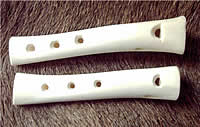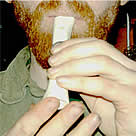

Wind Instruments
Coming soon: Willow Flutes, Gemshorns, Overtone Flutes, simple reedpipes and Viking Reed-pipes based on the Falster and Lund finds.
Bone Flutes
Our bone flutes are made with wooden fipple blocks held in place with beeswax. The bones are chemically bleached and sanitised. The bone flute is the most common musical instrument found in Viking and Anglo-Saxon archaeological contexts. The design we offer was in common use from the 9th century onwards, and may have been in use earlier, though this cannot be proven definitively as only partial remains exist. Our flutes are accurate recreations of this type of instrument.
Since these flutes are fipple or duct flutes like a tin whistle or recorder producing a tone is very easy, just blow gently into the end!
All the bone flutes are a good size to wear around the neck on a thong.
|
Sheep Bone Flute Although the sheep bone flutes have only 3 holes it is possible to get a scale of at least six notes and sometimes up to an octave by covering the end varying amounts with the fingers of one hand, whilst covering or uncovering different combinations of holes with the other and overblowing. Sheep bone flutes are difficult to tune due to the small size and the complex internal geometry, so with the sheep bone flutes we tend to follow the approach of the original makers of these instruments and put the holes in where they will fall comfortably under the fingers, and then work out how to play it afterwards. Thus all the flutes are different and each has its own playing characteristics and possibilities for cross fingering and overblowing, which you will discover with practice.Though to modern ears these different notes may sound out of tune with each other, a practised player will be able to tune them with their breath or cross fingering to produce either a modern minor or major scale. They are supplied with an instruction sheet. |
|
|
|
|
|
|
Deer Bone Flute I make deer bone flutes from both roe deer and red deer bones. They are made with between 4 and 6 fingerholes. It is possible to tune these instruments more accurately than the sheep bone flutes so more conventional fingering patterns and scales are possible. They are supplied with an instruction sheet. |
Picture coming soon. |
|
|
Horns
The Blowing Horn (also known as the 'Winding Horn, 'Cow Horn Trumpet'' or the 'Blast Horn') is surely one of mankinds oldest musical instruments. Musical instruments with a sound generated by buzzing the lips (the definition of the 'brass' family), made of both wood and animal horn, are known all over the world. However because these materials do not survive for long underground the oldest horns extant in Europe are metal, and date to the Bronze Age. A horn found in Intermessan in Scotland was side blown, and obviously modelled on an animal horn. It dated to around 800BC, and shows us that both metal and cow horns were in use in Britain at this time.
The oldest survivng animal horn is from around 1500 years later, from a deep bog in Visnum, Sweden. It was a cow horn, dated from the late Iron Age, and had five finger holes. Only slightly younger is the Ripon Charter Horn, given to the town of Ripon in 886 by Alfred the Great.This type of Blowing Horn is also made from a single cow horn.
Because of its many applications, for ceremonial use, adding atmosphere to re-enactment battles from practically all periods, as a re-enactors costume accessory or as a short range replacement for the mobile telephone, the simple blowing horn is our most popular item. We always keep a variety for immediate despatch.
Horns are a natural product so surface flaws may be present (especially in unpolished horns) and colours will vary.
|
Simple Blowing Horn made from a cow horn. Available polished or unpolished. These sound the same, but polished horns are more attractive. The picture to the right shows polished horns. Large horns are available side blown or end blown. Side blown horns are generally a little longer as these can be made without cutting the tip off the horn. Placing the hand into the end of the horn lowers the pitch so 2 or 3 different notes can usually be produced from a single horn. Occasionally cow horns can be overblown to give a much higher note, though this is often rather shrill or wooly sounding (brass instruments with a very conical bore, like cow horns, do not generally overblow in tune). They can also be played with circular breathing and other advanced techniques such as humming or singing into the horn whilst playing can give other textures and sounds.
|
||||
|
||||
|
||||
|
||||
|
Prillar Horn This is a cow horn trumpet with 3 fingerholes, a traditional instrument from Scandinavia. Horns with fingerholes date back to at least the 9th century. They are also know as Vallhorn. A horn like this is carefully tuned and plays a minor scale of 6 notes by various combinations of fingering the holes with one hand and closing the end with the other. Included is an instruction sheet in English. A book in Swedish with an English summary which includes many melodies and photographs is also available. |
 |
|
|
|
|
|
Viking Panpipe Archaeologists have now found several examples, from diverse periods and locations, of panpipes made from drilling out blocks of wood, rather than the more familiar construction of cane. Two of these instruments dated from the first century CE and were found in Switzerland and Germany. The third was found in the Viking layer of old York, in England. These boxwood Viking panpipes have become known as the Jorvik Panpipes, after the old name for York, Jorvik. This design of panpipe is still in use in Spain where they are associated with itinerant knife sharpeners. Being small enough to fit in a pocket or hang around the neck, and much tougher than pipes made from cane (indeed almost indestructable) the wood-block style of pipe is a very practical instrument. One can imagine it being the 'cowboy harmonica' of the Dark Ages, brought out around the campfire or for an impromtu dance session. The original instrument had relatively shallow holes (it may have been unfinished) and thus was very high pitched and piercing. I have decided to modify the instrument slightly and thus bore the holes out as deeply as possible for the overall size of the instrument. It thus makes a rather more musical sound. I can make a more exact replica on request. Our panpipes are usually made from native hardwoods other than the original boxwood. Boxwood pipes are occasionally available at a significantly higher price. |
|
|
|
|
|
|
Bullroarer The bullroarer is one of the few musical instruments known on every continent. Neolithic bullroarers of tremendous antiquity have been found, and it must be considered an instrument that is part of our common human heritage. It has always been used to signify the presence of spirits, whether this be a Turndun played during an Australian Aboriginal initiation, a Rhombos played in ancient Greek rituals, a Maori Purerehua, or a Basque Toulouhou played during a Catholic festival to symbolise the presence of the Devil... The ultra low frequency sound generated by a Bullroarer is known to have effects on brainwaves and the instrument can be used as a tool to help produce an altered state of consciousness. Its arresting and mysterious sound is useful to signal the start or end of a ceremony or ritual. We make our bullroarers from native British hardwoods, generally Ash or Oak, but occassionally Yew, Holly or other hardwoods. Large bullroarers are no louder than their smaller comrades, though the sound is lower pitched and it is scarier to watch (and use)! Supplied with an instruction sheet and spare string. |
|
|
|
|
|

